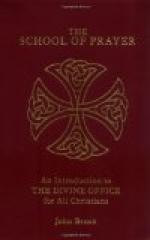The Apparition of St. Michael. The cultus of the holy angels is of Jewish origin and existed in the Christian Church from the beginning. In St. Paul’s Epistle to the Colossians (modern Khonus on the Lycus) he speaks of this devotion and of the attempts of a Gnostic sect to spread false doctrines on this point (Col. ii, 18). Although the evil wrought was long lived, true devotion to the angels was practised in Colossae and there the Archangel Michael appeared. In honour of this apparition, the festival of St. Michael in September was established. Devotion to the Archangel was of very early date in Rome and in the Western Church generally. Masses in his honour are found in the oldest Roman Sacramentary (483-492); and in these he is mentioned by name in prayers and prefaces. The May feast was instituted in the sixth century, to commemorate a second apparition near Sipontum on Monte Gargano, which took place on the 8th May, 520.
June 29. Feast of St. Peter and St. Paul. There always has been a constant tradition in Rome that these two saints suffered martyrdom on the same day, 29th June, and it is only natural that this day should be kept with great devotion and solemnity at Rome. In the East, feasts in honour of these martyrs were held at different seasons, Christmas, February and Epiphany. The day was kept in many places as a solemn holiday, servile works being prohibited. But in Rome, devotion was closely connected with the date and with the exact places of martyrdom. “Owing to the distance which separated the two churches of the apostles from each other, it was most fatiguing to celebrate Mass at both places, and so in course of time the festival was divided into two parts, and the Mass in honour of St. Paul took place on the 3Oth June.”
July. The Visitation. This feast was probably originated by the Franciscans in the thirteenth century. It certainly was preached and spread by their zeal. It is mentioned amongst Franciscan records bearing date 1263. It was kept in different places at different dates. In Paris it was kept in April. In 1850 Pius IX. raised this feast to the rank of a double of the second class, to thank God for having, on this day, 2nd July, freed Rome from the revolutionary yoke.
Feast of St. Mary Magdalen. Commentators on Sacred Scripture are not agreed whether Mary of Magdala was the sister of Lazarus or whether there were two or three Marys connected with our Lord—Mary the sister of Lazarus, Mary of Magdala, and Mary the sinner named in St. Luke’s Gospel vii. 27. The Roman liturgy seems to favour the opinion that Mary of Magdala was the sister of Lazarus, and that she was a sinner and was possessed by seven devils. The history of Mary Magdalen after our Lord’s death has been written, with large and varied additions of adventure, by pious mediaevalists. In the Western Church, traces of the saint’s cultus are met with in Bede and his contemporaries. But devotion far and wide begins with mediaeval times. The many legends which have grown up around her name and history have so obscured historic truth that the Breviary gives no historic lessons on her feast day, but gives as a lesson part of a homily from St. Gregory. Some of the legends may be found in the Office of St. Martha (July, 29th).




